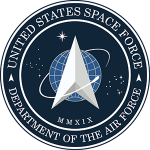US Space Force: Funding, Personnel, & Working with Commercial Industry
By Sharon Lo, Managing Editor, DTJ & The Source
During last week’s State of the Union address, President Donald Trump touted the creation of the US Space Force as one of the key accomplishments of his administration. Here is what you should know about the newest branch of our armed forces.
 Establishment
Establishment
In June 2018, President Trump directed the Pentagon to establish a US Space Force. However, the service wasn’t officially established until the National Defense Authorization Act (NDAA) was passed by Congress and subsequently signed by the president on December 20, 2019.
Space Force became the sixth branch of the US military and the first new service since the Air Force stood up in 1947.
Purpose
Spurred by increasing space ambitions and capabilities of several other countries, most notably China and Russia, Space Force is designed to help protect the interests of the US in space, deter aggression in the final frontier, and conduct prompt and sustained space operations.
Space Command will take over US military space operations previously managed by the Air Force Space Command, a major command within the US Air Force. These duties include the procurement and operation of military space technology; the management of programs such as Global Positioning System (GPS), the Defense Meteorological Satellite, and the Space-Based Infrared System; and operation of the Delta II, Delta IV and Atlas V launch vehicles, among other operations.
Funding
This week the Pentagon proposed a budget of $15.4 billion for the Space Force in Fiscal Year 2021 (FY21). This money would be transferred largely from existing Air Force programs. The amount includes $2.5 billion for operations and maintenance, $10.3 billion for research and development, $2.4 billion for procurement, and $77 million from a war fund known as the Overseas Contingency Operations (OCO) account.
Personnel
The FY21 budget documents also called for personnel totaling 6,434 active-duty Space Force members and 3,545 civilians. Where will all these people come from, you ask? The plan is to transfer thousands of Airmen who currently perform space duties into Space Force.
Those who wish to transfer into Space Force will need to formally resign their commission or terminate their enlistment with the Air Force, Army, or Navy, and re-commission or re-enlist into the Space Force.
And while an official name for these service members—one equivalent to Soldiers, Sailors, Airmen, Marines, etc.—has yet to be decided upon, the Pentagon has already ruled out calling them “Spacemen” or “Space Cadets.”
Organization
Though many details remain uncertain, plans for the service’s organizational structure have begun to emerge. Initial plans lay out an Office of the Chief of Space Operations, which includes three directorates for human capital and logistics; operations, cyber and intelligence; and plans, programs, requirements and analysis. Patricia Mulcahy, a member of the Senior Executive Service, has already been assigned as the director for human capital and logistics.
Space Force Studies Commercial Industry
The two-star general in charge of strategic requirements for the Space Force is overseeing a study that will examine the capabilities of the commercial space industry. Being conducted by the RAND Corp., the study will identify commercial space technologies that the Space Force could put into use, as well as potential risks of employing commercial systems during an armed conflict.
Additionally, the Air Force Space and Missile Systems Center recently hosted one-on-one meetings with executives from 30 companies from across the space industry. This was the start of a multiyear market study that will influence Air Force (and Space Force) spending on private-sector technologies and services over the coming decade.
Industry Pitch Day
To gain even greater insights into what commercial industry may be able to offer, the 45th Space Wing, based out of Patrick Air Force Base in Brevard County, Florida, is holding a Space Force pitch day on March 4, 2020. The event follows in the footsteps of a new Air Force acquisition setup intended to find innovative solutions from small, nontraditional companies.
Similar to the television show, “Shark Tank,” the Air Force’s pitch days see commercial vendors present proposals for technologies or procedures to Air Force personnel, who are authorized to award Small Business Innovation Research contracts on the spot.
